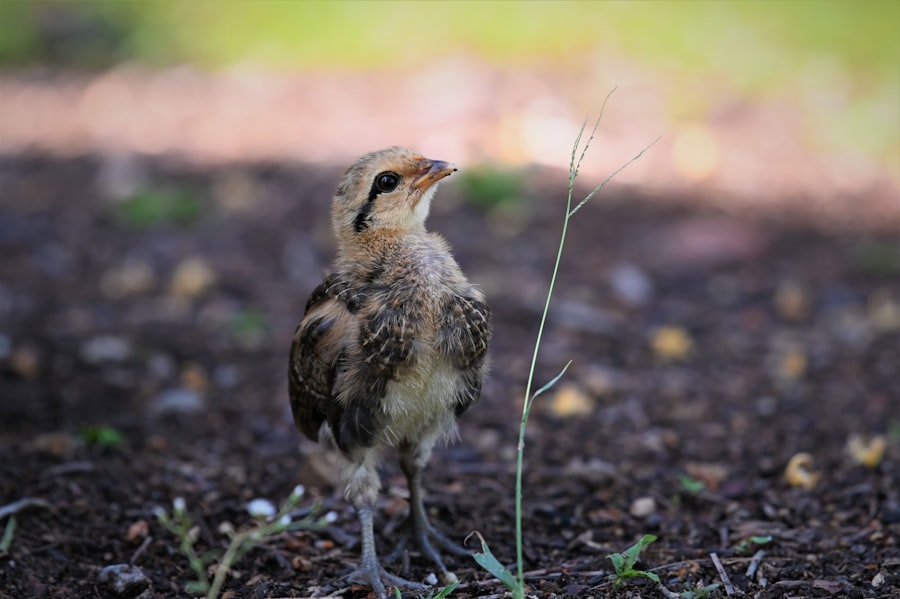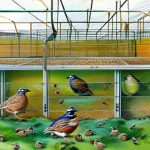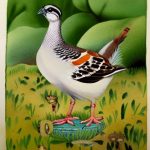Blue Scale Quail, also known as Blue Quail or Cotton Top Quail, are a popular game bird species native to the southwestern United States and Mexico. They are known for their striking blue-gray plumage and distinctive white-tipped feathers on their heads, which give them a unique and attractive appearance. Blue Scale Quail are also prized for their delicious meat and are often raised for hunting purposes or as pets.
Breeding Blue Scale Quail can be a rewarding and profitable venture for those interested in aviculture. Whether you are a hobbyist looking to raise these beautiful birds for personal enjoyment or a commercial breeder seeking to supply the demand for game birds, understanding the ins and outs of Blue Scale Quail breeding is essential for success. This article will provide a comprehensive guide to breeding Blue Scale Quail, covering everything from selecting breeding stock to rearing chicks and marketing your birds.
Table of Contents
Key Takeaways
- Blue Scale Quail breeding is a rewarding and relatively easy endeavor for those interested in raising these unique birds.
- When selecting breeding stock, it is important to choose healthy, unrelated birds with desirable traits such as good size, color, and temperament.
- Breeding enclosures should provide ample space, shelter, and protection from predators, as well as suitable nesting areas for the quail.
- Incubation and hatching require careful monitoring of temperature and humidity, as well as regular turning of the eggs for successful hatching.
- Rearing chicks involves providing a balanced diet, warmth, and protection from predators, as well as regular monitoring of their health and development.
- Health and nutrition are crucial for the well-being of Blue Scale Quail, with a focus on providing a balanced diet and regular health checks.
- Selling and marketing Blue Scale Quail can be done through local markets, online platforms, or directly to other breeders and enthusiasts.
Selecting Breeding Stock
Selecting the right breeding stock is crucial for producing healthy and high-quality Blue Scale Quail offspring. When choosing breeding stock, it is important to look for birds that are in good physical condition, free from any signs of illness or deformities. Look for birds with bright, clear eyes, smooth feathers, and a lively demeanor. Avoid birds that appear lethargic, have disheveled feathers, or show any signs of respiratory distress.
In addition to physical health, it is also important to consider the genetic diversity of your breeding stock. Inbreeding can lead to a host of health issues and genetic abnormalities in offspring, so it is best to avoid mating closely related birds. Instead, aim to introduce new bloodlines into your breeding program periodically to maintain genetic diversity and vigor in your quail population. By carefully selecting breeding stock based on health and genetic diversity, you can lay the foundation for a successful and sustainable Blue Scale Quail breeding program.
Breeding Enclosures and Set-Up
Creating the right breeding environment is essential for the health and productivity of your Blue Scale Quail. Breeding enclosures should provide ample space for the birds to move around freely and engage in natural behaviors such as dust bathing and foraging. A good rule of thumb is to provide at least 1 square foot of space per bird to ensure they have enough room to thrive.
The enclosure should also be equipped with appropriate nesting areas to encourage breeding behavior. Provide plenty of low, covered areas with soft bedding material where the quail can lay their eggs in privacy. Additionally, it is important to provide a balanced diet for your breeding quail to ensure they have the nutrients they need for successful reproduction. A diet high in protein and calcium is essential for egg production and chick development.
Finally, pay attention to the environmental conditions within the breeding enclosure. Blue Scale Quail are sensitive to temperature extremes, so it is important to provide adequate heating and cooling as needed. Additionally, maintaining proper humidity levels is crucial for successful egg incubation. By creating a well-designed breeding environment with ample space, nesting areas, proper nutrition, and ideal environmental conditions, you can set the stage for successful Blue Scale Quail breeding.
Incubation and Hatching
Once your breeding quail have laid their eggs, it is time to move them to an incubator for hatching. Proper incubation is crucial for the development of healthy chicks, so it is important to invest in a high-quality incubator that provides consistent temperature and humidity control. The ideal temperature for incubating Blue Scale Quail eggs is around 99.5 degrees Fahrenheit, with a humidity level of 50-60% for the first 14 days, then increasing to 65-70% for the final days before hatching.
During the incubation period, it is important to regularly monitor the temperature and humidity levels within the incubator to ensure they remain within the optimal range. Turning the eggs several times a day is also essential for proper development, as it helps prevent the embryo from sticking to the shell membrane. After about 23-24 days of incubation, the eggs will begin to hatch, and you will need to closely monitor the hatching process to ensure that the chicks are healthy and able to move freely.
Once the chicks have hatched, it is important to transfer them to a brooder where they can be kept warm and safe while they continue to develop. Provide a heat source such as a heat lamp or heating pad to maintain a temperature of around 95 degrees Fahrenheit for the first week, gradually decreasing by 5 degrees each week until they are fully feathered. By carefully managing the incubation and hatching process, you can maximize the chances of producing healthy Blue Scale Quail chicks.
Rearing Chicks
Rearing Blue Scale Quail chicks requires careful attention to their nutritional needs and environmental conditions. In the first few weeks of life, chicks should be provided with a high-protein starter feed to support their rapid growth and development. Additionally, it is important to provide access to clean water at all times to prevent dehydration.
As the chicks grow, it is important to gradually introduce them to solid foods such as grains and greens to encourage natural feeding behaviors. Providing plenty of space for the chicks to move around and engage in natural behaviors is also essential for their physical and psychological development. Additionally, it is important to monitor the chicks for any signs of illness or distress and provide prompt veterinary care as needed.
As the chicks mature, they will begin to develop their distinctive blue-gray plumage and white-tipped feathers on their heads. By providing proper nutrition, space, and care throughout the rearing process, you can ensure that your Blue Scale Quail chicks grow into healthy and vibrant adults ready for breeding or sale.
Health and Nutrition

Maintaining the health and nutrition of your Blue Scale Quail is essential for successful breeding and production. A balanced diet rich in protein, vitamins, and minerals is crucial for supporting egg production, chick development, and overall health. Provide a high-quality game bird feed supplemented with fresh greens, grains, and occasional treats such as mealworms or fruits to ensure that your quail receive all the nutrients they need.
Regular health checks are also important for monitoring the well-being of your quail flock. Look out for any signs of illness such as lethargy, loss of appetite, respiratory distress, or abnormal droppings, and seek veterinary care as needed. Additionally, maintaining a clean and well-ventilated living environment is essential for preventing disease outbreaks and promoting overall health.
It is also important to provide access to clean water at all times to prevent dehydration and support proper digestion. Regularly clean waterers and feeders to prevent contamination and ensure that your quail have access to fresh, clean food and water at all times. By prioritizing the health and nutrition of your Blue Scale Quail flock, you can ensure that they are in prime condition for breeding and production.
Selling and Marketing Blue Scale Quail
Once you have successfully bred and reared your Blue Scale Quail, it is time to consider selling and marketing your birds. There is a strong demand for game birds among hunters, hobbyists, and pet owners, making Blue Scale Quail a valuable commodity in the aviculture market. Consider reaching out to local hunting clubs, game preserves, pet stores, or online marketplaces to find potential buyers for your quail.
When marketing your Blue Scale Quail, highlight their attractive appearance, delicious meat, and easy-to-care-for nature as selling points. Consider offering packages that include breeding pairs or starter flocks for those interested in raising their own quail. Additionally, consider offering educational resources or workshops on quail care and breeding to attract potential buyers who may be new to raising game birds.
Networking with other breeders and aviculture enthusiasts can also help you find potential buyers for your quail. Consider attending bird shows, fairs, or other aviculture events where you can showcase your birds and connect with potential buyers. By effectively marketing your Blue Scale Quail and building a strong network within the aviculture community, you can successfully sell your birds and establish a reputation as a reputable breeder in the industry.
In conclusion, breeding Blue Scale Quail can be a rewarding and profitable venture for those interested in aviculture. By carefully selecting breeding stock, creating optimal breeding enclosures, managing incubation and hatching processes, rearing chicks with proper care, prioritizing health and nutrition, and effectively marketing your birds, you can establish a successful Blue Scale Quail breeding program. With dedication, knowledge, and attention to detail, you can enjoy the satisfaction of raising these beautiful birds while meeting the demand for game birds in the aviculture market.
If you’re interested in breeding blue scale quail, you may also want to consider the importance of providing a suitable environment for your poultry. In a recent article on PoultryWizard, “Where to Put Your Chicken Coop,” the author discusses the significance of choosing the right location for your coop to ensure the health and well-being of your birds. This article offers valuable insights that can be applied to creating an optimal setting for breeding and raising blue scale quail. Check it out here.
FAQs
What is the breeding season for blue scale quail?
Blue scale quail typically breed from late spring to early summer, with peak breeding activity occurring in May and June.
How do you create a suitable breeding environment for blue scale quail?
To create a suitable breeding environment for blue scale quail, provide a spacious and well-ventilated enclosure with plenty of hiding spots and nesting materials. The enclosure should also have a balanced ratio of males to females to prevent aggression during breeding.
What is the incubation period for blue scale quail eggs?
The incubation period for blue scale quail eggs is approximately 21 days. It is important to maintain a consistent temperature and humidity level during this period to ensure successful hatching.
What do blue scale quail chicks eat?
Blue scale quail chicks should be provided with a high-protein starter feed specifically designed for game birds. Additionally, they can also benefit from small insects and greens to supplement their diet.
At what age do blue scale quail reach sexual maturity?
Blue scale quail typically reach sexual maturity at around 8 to 10 weeks of age. It is important to separate young quail from adults to prevent early breeding and potential health issues.
Meet Walter, the feathered-friend fanatic of Florida! Nestled in the sunshine state, Walter struts through life with his feathered companions, clucking his way to happiness. With a coop that’s fancier than a five-star hotel, he’s the Don Juan of the chicken world. When he’s not teaching his hens to do the cha-cha, you’ll find him in a heated debate with his prized rooster, Sir Clucks-a-Lot. Walter’s poultry passion is no yolk; he’s the sunny-side-up guy you never knew you needed in your flock of friends!







